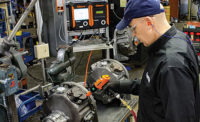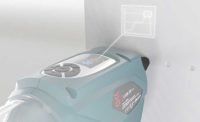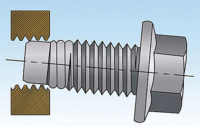To the general public, a washer is just a cheap metal disc that keeps screws, bolts, and nuts tight. But to manufacturers, a washer is a vital fastening component, specially designed to perform unique functions and ensure a reliable bolted joint.
Every year manufacturers use billions of washers, which are made of various materials and come in many thicknesses, diameters, finishes and grades. Suppliers estimate that manufacturers use about two-thirds of their washers for assembly applications and the remainder for maintenance of their production equipment.
Most washers are used to distribute the clamp load applied by a threaded fastener. Other washers are designed to help keep a fastener locked in place or insulated, such as from moisture and electricity. Still others are placed on shafts to function as a spacer or bearing within an assembly.
“When used properly, washers can truly benefit product assembly,” says Greg Fields, president of Fastener SuperStore Inc. “When used improperly, unnecessarily, or to cover up design or production flaws, washers may provide no benefit at all, while adding to the cost of a project.”
Standard Types
According to the Precision Metalforming Association, there are six standard types of washers: flat, shoulder, tab, lock, countersunk and spring. All of these washers are used with fasteners.
Flat washers are the most popular type and come in many configurations. They feature flat top and bottom surfaces, and an inner and outer shape that may be round, square, rectangular or hexagonal. The washer’s main purpose is to distribute fastener load and reduce heat and friction during installation.
Cash Sigler, sales and marketing manager for Seastrom Manufacturing Co. Inc., says flat washers can also be used as a spacer. For example, he knows of one manufacturer that uses a flat washer between two surfaces within the pivot point of a robot arm to prevent them from rubbing against each other.
“This washer is hard enough to withstand the pressure, but thin enough to not hinder motion,” says Sigler. “The washer is Teflon and only 0.05- or 0.062-inch thick.”
Fields says flat washers can be further divided into many subcategories, based on either shape or a specific industry standard (USS or SAE). The shape categories encompass fender, dock, structural and thru-hard washers.
USS (United States Standard) washers are designed to meet the requirements of most domestic industrial and assembly applications. SAE (Society of Automotive Engineers) washers are designed more specifically for the auto industry, says Fields, but they can be used when a slightly smaller outer diameter is required.
A fender washer has an outside diameter that is proportionally much larger than its center hole, enabling it to provide an extra-wide bearing surface for distributing force. Dock washers are basically thick fender washers (up to 0.25 inch) with a galvanized finish for corrosion resistance.
Structural washers have a top-bearing surface that is cut at an oblique angle to compensate for nonparallel surfaces. Thru-hard washers are heat treated and made of high-grade steel to tight tolerances.
Shoulder washers look somewhat like a crowned top hat. Known also as flange or step washers, they are used as a bushing to insulate fasteners or shafts within electronic equipment. As a result, shoulder washers are made of nonconductive materials, usually nylon. They are not recommended for humid environments.
Made of metallic or nonmetallic materials, tab washers feature internal or external tabs or notches that prevent the washer from rotating relative to the fastener or shaft. Tab configurations can vary and include single or multiple, formed or flat.
Lock washers are made of hardened metal and feature either a helical-shape split ring or internal or external teeth (serrations). During fastener installation, the helical version exerts a spring force between the fastener’s head and substrate to create increased friction and resistance to motion.
The internal-toothed version bites into the nut or screw head and the surface it contacts, whereas the external-toothed version bites into the bearing surface. Sigler says toothed washers are very effective when used with soft plastic and aluminum substrates. Fields says the external-toothed washer provides a stronger hold than the internal-toothed washer due to the larger radius of the teeth.
Countersunk washers look similar to a dog bowl with a hole in the bottom. The washer’s countersunk head may be angled up to 90 degrees or feature flanges. These washers are often used on consumer products, such as cabinetry, because they are aesthetically pleasing and allow flat or oval head countersunk screws to be installed flush with the part surface.
Seastrom offers these washers in metallic materials. The metallic type are stamped and often plated to provide a decorative finish. A countersunk washer can also be nonmetallic (including nylon) and molded.
There are three types of spring washers, which are used to limit fastener movement due to vibration or thermal expansion. The washers are metallic and used in place of comparable springs, which cost and weigh more, and occupy more space. Aerospace companies frequently use spring washers in actuators located throughout an airplane, including the flight controls and landing gear.
Because curved washers offer the highest deflection range of the three types, they are recommended for applications that require flexibility, frequent load cycling and light loads (up to 100 pounds). For these washers to function properly, the formed portion must be free to slide.
Wave washers usually have three, four or six curvilinear lobes, although almost any number is possible. These washers don’t deflect weight until all lobes are uniform and evenly loaded. They are recommended for applications involving static loads and limited axial space.
A third type is Belleville washers, which have the form of a truncated cone or sphere. These washers offer the smallest deflection range but the highest load capacity. When deformed, they provide an axial force. Belleville washers, like the other two types, are sometimes tempered to a specified hardness. Specifically, they are made from stainless or carbon steel, beryllium copper or phosphor bronze.
What’s Your Specialty?
Suppliers say that manufacturers are increasingly using specialty and custom washers, although they still account for a small percentage of washers used in assembly. A specialty washer is a proprietary product that can be used by any manufacturer, whereas a custom washer is made specifically by a washer supplier for one manufacturer.
“The innovation of specialty washers provides a major benefit to design engineers,” says Brian Dengel, product manager for All Metric Small Parts, which supplies standard and custom washers. “They can focus on other assembly components, confident that the specialty washer will perform better than a standard washer.”
Workers at Siemens Industrial Turbomachinery AB in Finspang, Sweden, would agree. There they use specialty washers made by Nord-Lock International AB to assemble steam and gas turbines from machined steel parts. The washers increase productivity, are corrosion-resistant and can be reused.
Each washer consists of a top and bottom that, during bolt tightening, interlock to create tension and positively lock the bolt in place. Tension develops because the cam angle of the washer is larger than the thread pitch of the bolt. In essence, the bolt self locks and remains that way even when subjected to extreme vibration or dynamic loads.
Several suppliers offer custom washers. About 70 percent of the washers made by Wrought Washer Manufacturing Inc. are custom, says Paul Schulz, president. The company also makes standard and “special” common washers, the latter type having irregular shapes such as C, D, rectangular, square and off-center hole.
For the past several years, Wrought Washer has been making a high-volume custom washer for a manufacturer of heavy construction equipment. The washer functions as a spacer and is placed on a shaft between two pieces of metal.
“Initially, we made it of brown bar stock and then machined it with a CNC,” says Shulz. “But in reviewing the part’s blueprint and specs, we noticed that the tolerance on certain features lent themselves to a stamped part with an additional secondary operation. So we made a sample part, and the customer liked it. Converting to automated stamping has saved the customer $250,000 thus far.”
Seastrom and Spirol Corp. also make custom washers. Sigler says an electronics manufacturer uses a stainless steel spider-like washer made by Seastrom. The washer features 12 short fingers within its center and 12 long legs on the outside. It is locked onto a cathode ray tube that performs bar code reading. The legs are mechanically wrapped around the tube to secure and protect it.
Spirol makes thrust washers, which are used as a bearing to prevent lateral movement of spinning shafts. Ingo Rutenberg, shim division sales manager for Spirol Corp., says automotive and heavy-equipment manufacturers require the washers be made to a precise thickness to maximize the wear life of the assembly. The washers can be case- or through-hardened to customer specifications.
Question Selection
With so many washers to choose from, how does a manufacturer select the best one for a specific application? Dave Archer, president of Archetype Joint LLC, says companies need to decide if they want to use a washer, and, if so, determine the benefit they hope to gain through their use. While most often used to prevent vibration loosening, washers also prevent joint relaxation and provide a common bearing surface.
“Some OEMs automatically want a locking mechanism, such as a washer, on every bolt,” says Archer. “At other companies, the engineer selects the bolt and washer.”
Sigler says manufacturers need to remember that washer thickness, diameter and strength always impacts the length, diameter and capability of the fastener. In addition, they must factor in space restrictions within the bolted joint and the environment where the fastened part is used.
“Tight spaces might require the washer to be angled and custom-made,” says Sigler. “As for environment, determine if the washer needs to allow conductivity or insulate the fastener from corrosion.”
Finally, manufacturers have to decide if they want to install washers manually or with automation. This decision should never be based on the assumption that every standard washer can be installed with automation.
For example, a few years ago a water-pump manufacturer had Seastrom make batches of a custom washer that could be automatically fed from a tube onto a fastener. The manufacturer had been using a standard washer, which had ever-so-slight edge variations throughout each batch. The variations caused some washers to get stuck in the feeding tube, disrupting production.
Another option for manufacturers is to use SEMS screws or Keps nuts, which have a retained washer and can be installed manually or with automation. Both products are made by ITW Shakeproof.
A Smarter Future
Manufacturers love innovation and welcome it in all assembly processes, especially fastening. That’s great news for three Hong Kong teens who, this past May, unveiled their Smart Alert specialty washer at the 2013 Intel International Science and Engineering Fair in Phoenix.
The washer is designed to lift a flag when the attached nut begins to loosen. It can be used in any bolted joint.
The washer actually consists of two washers. One is a standard flat washer, but the other has a small color segment connected to a spring. When the Smart Alert washer is installed, the loose segment is hidden and held in place by the nut. If the nut becomes loose, the spring is released and raises the color segment.
“There’s a growing awareness and appreciation for reliable bolted joints, and that’s a great thing,” says Archer. “This increases the potential for people to develop innovative bolts, nuts and washers.”
Assembly Online
For more information on washers, check out these articles:










